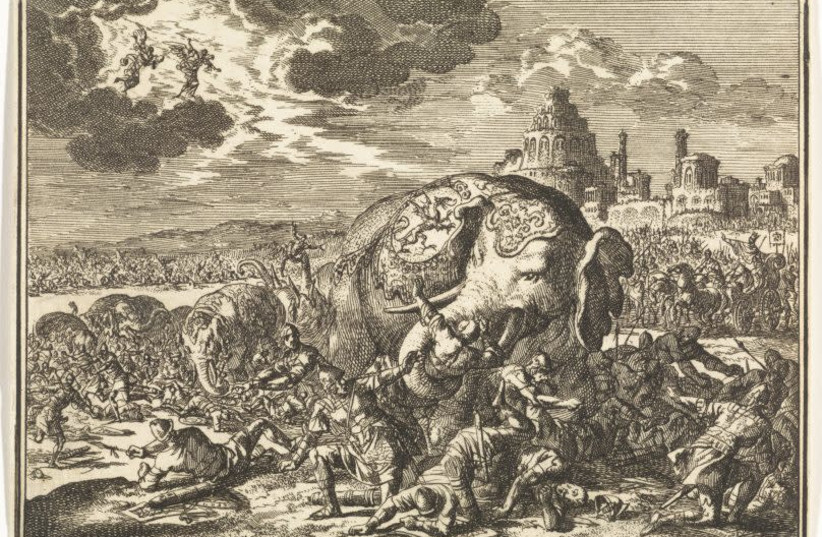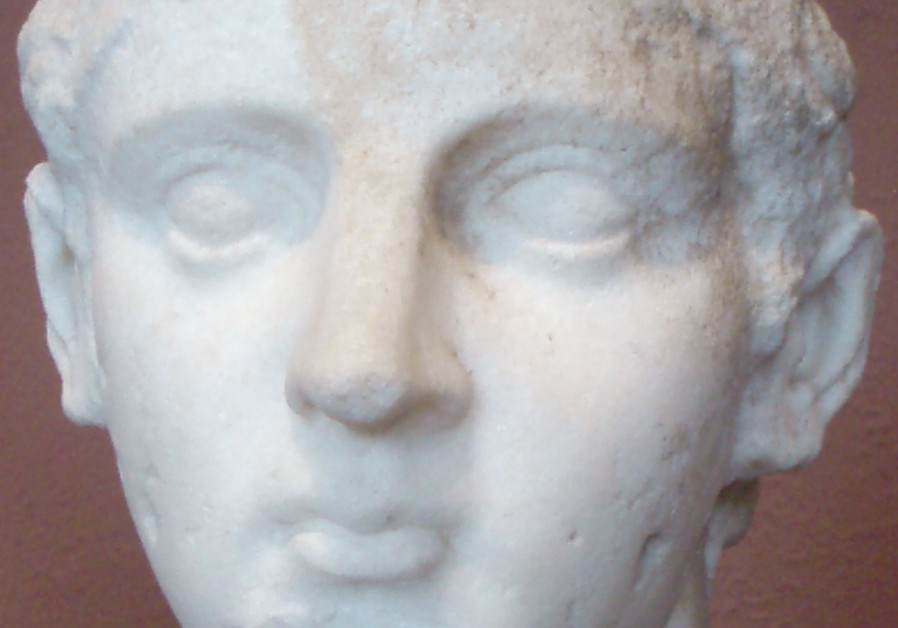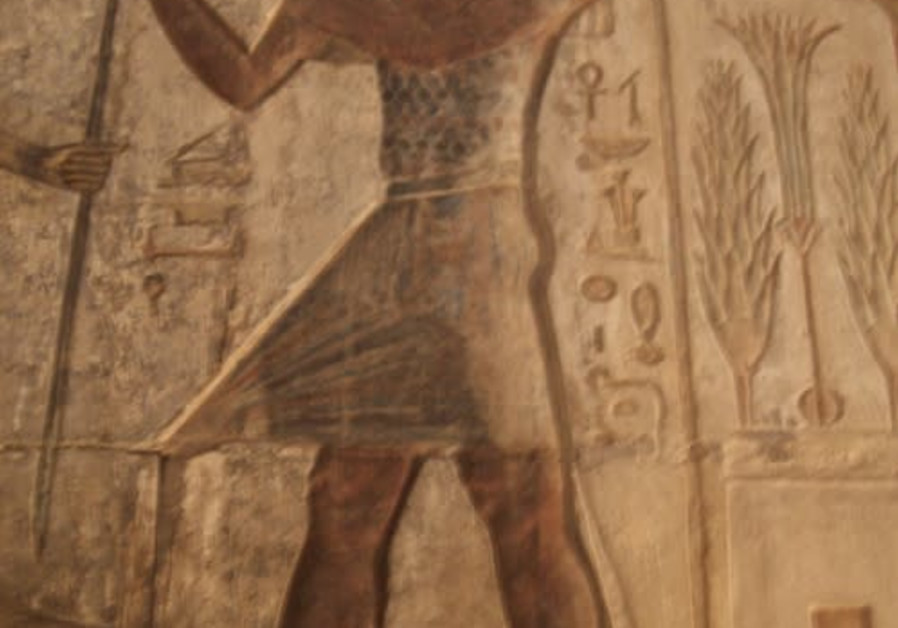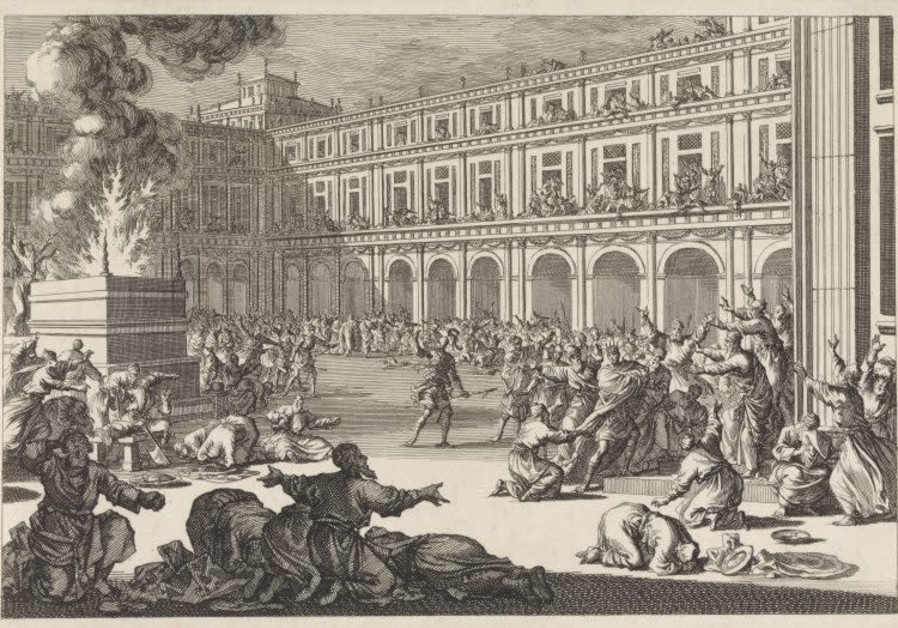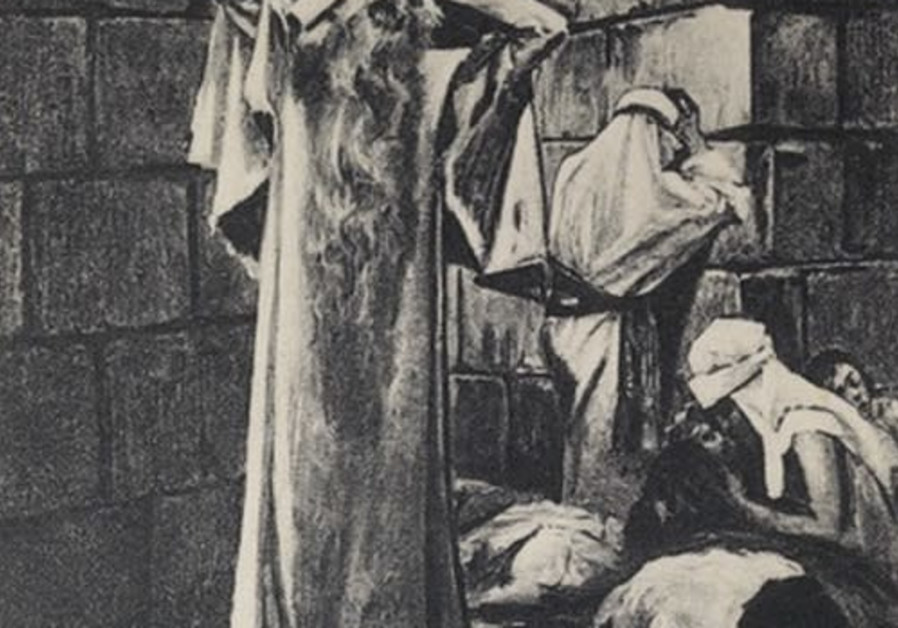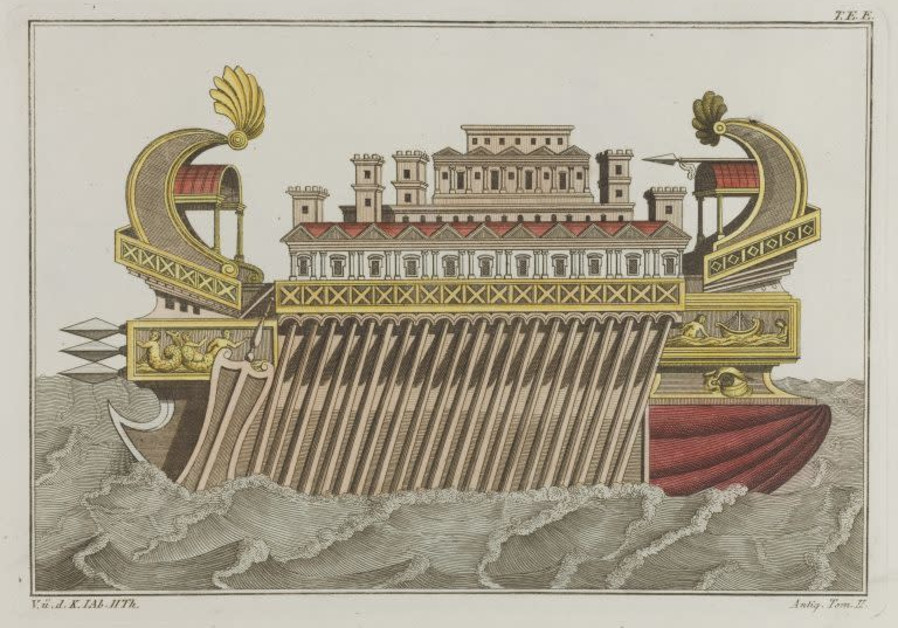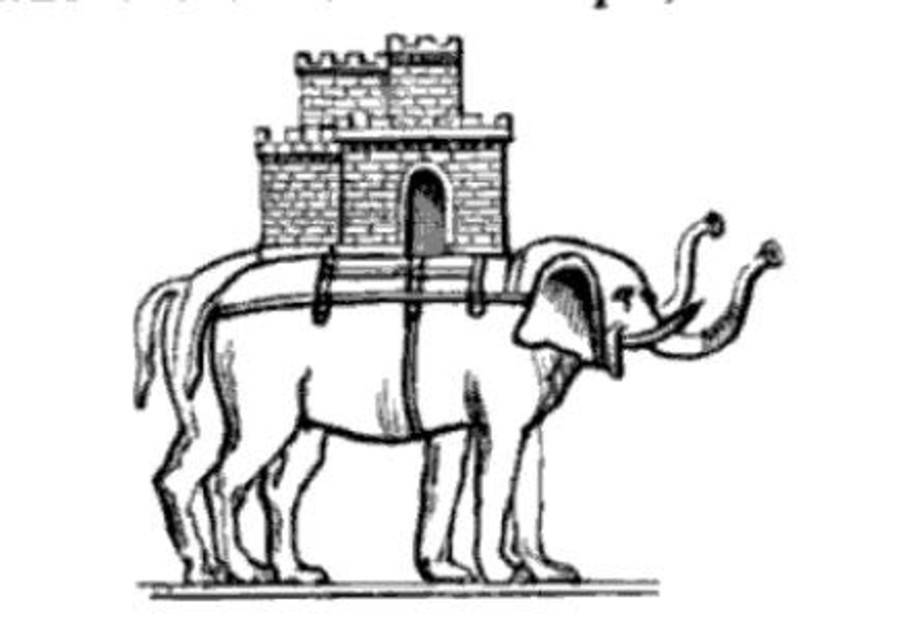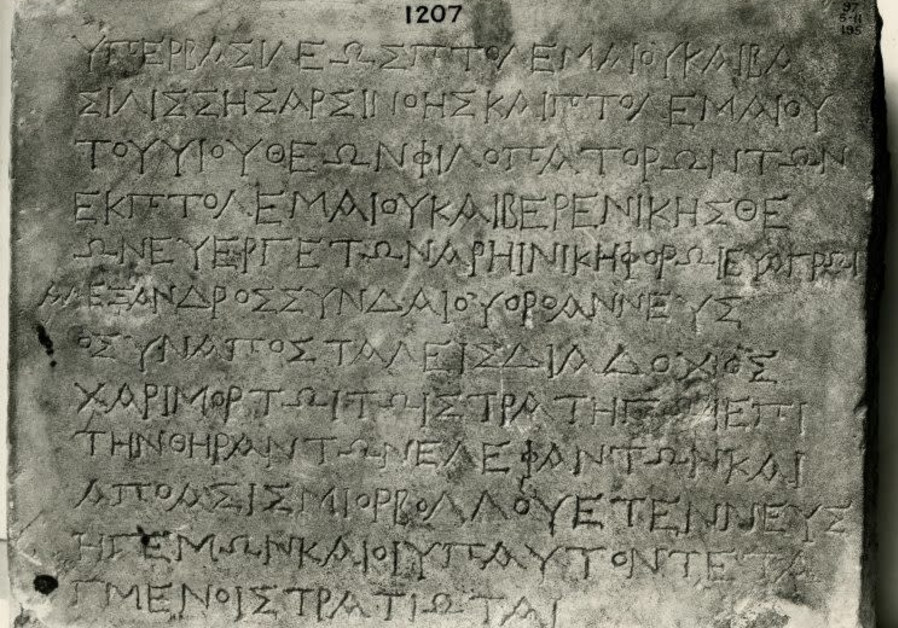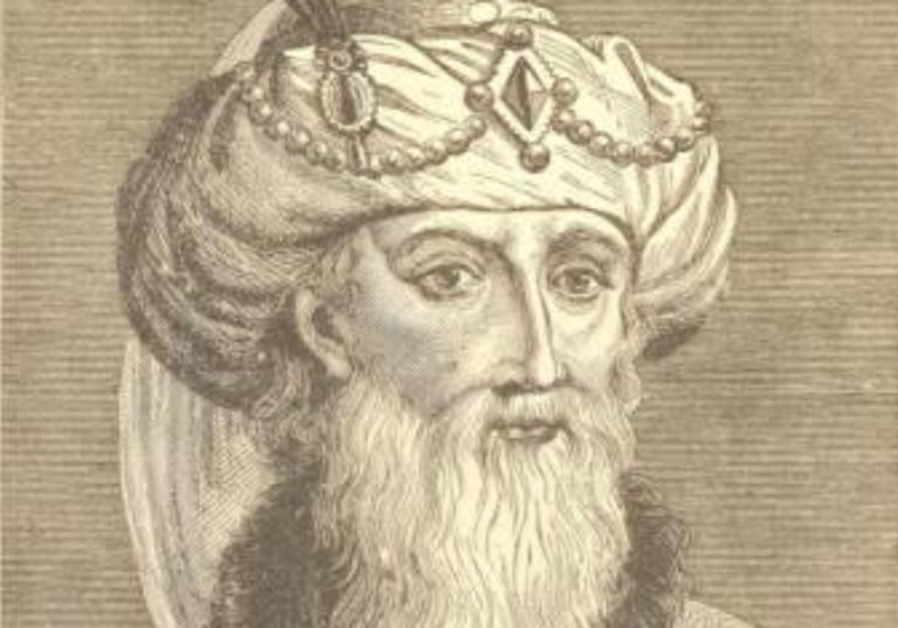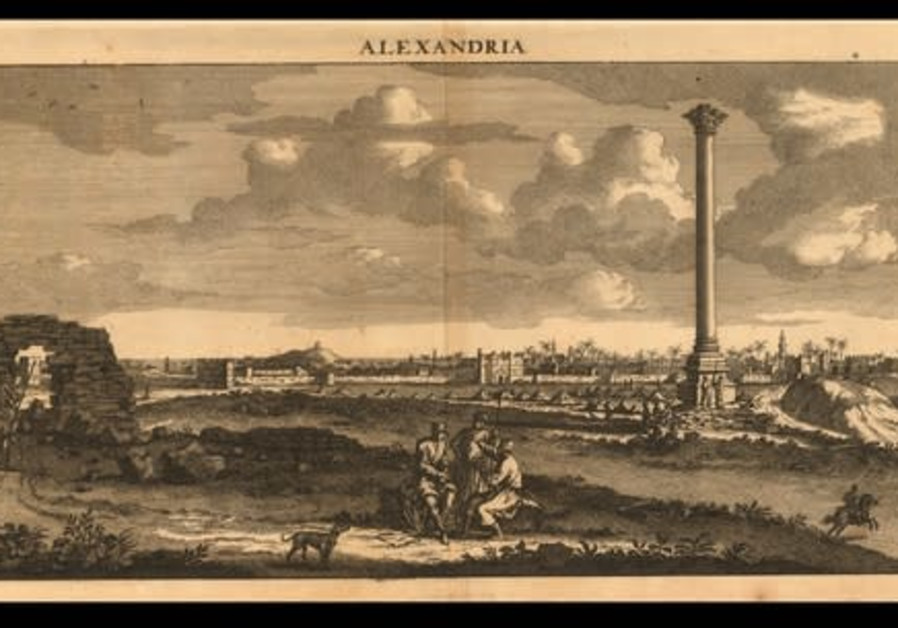A different kind of redemption from Greek tyranny
Antiochus and his elephants left Gaza in defeat.
One of the largest battles of the ancient world was over – apparently the first time Asian and African elephants had faced off against one another – though the victor’s herd had been of little help, famously fleeing the war zone in a crazed frenzy.
The defeated Antiochus was not the one of Hanukkah fame. That would be his son, Antiochus IV Epiphanes.
And the victor was not a Maccabee, but rather a Ptolemy: Ptolemy IV Philopator, to be more precise, the Greek pharaoh of Egypt who reigned before the story of Hanukkah took place.
Statue head of Ptolemy IV, now in the Museum of Fine Arts, Boston. (Photo credit: Keith Schengili-Roberts/National Library of Israel)
As pharaoh, Ptolemy was already considered a divine figure, but he would become even more so following his victory at the Battle of Raphia, as his clash with Antiochus was known.
His subsequent “Raphia Decree” was copied and proclaimed throughout the empire, celebrating the victory, chronicling how the gods had helped him rout his rival and take the latter’s riches (including his elephants).
Ptolemy proceeded to visit and renovate countless pagan temples, repaying the gods for enabling his victory, and erecting graven images all over the place.
Temple relief of Ptolemy IV Philopater at Deir el-Medina. (Photo credit: Kyera Giannini/Institute for the Study of the Ancient World/National Library of Israel)
Nonetheless, Ptolemy was not destined to become an infamous villain in Jewish tradition like the son of his foe, though he does play a similar role in the apocryphal, historically suspect and inaccurately labeled Third Book of Maccabees (or III Maccabees).
The Third Book of Maccabees
Written in Greek, most likely by an Alexandrian Jew sometime in the first century BCE, the Third Book of Maccabees doesn’t really have anything to do with the Maccabees at all, though thematically and stylistically there are certainly some similarities with the far better known story of Hanukkah.
After briefly recounting a foiled plot to assassinate Ptolemy and his victory over Antiochus (inspired by an enthusiastic pep talk given to the troops by his wife/sister Arsinoe), the story joins the pharaoh on his grand tour of pagan temples, which ultimately leads him to Jerusalem and the Holy Temple of the very non-pagan Jews.
Ptolemy brings an offering of thanks to the Jews’ one and only God, and is impressed by the beauty and grandeur of their Temple.
He approaches the Holy of Holies – the revered chamber into which only one man is allowed to enter one day each year: the High Priest on Yom Kippur, the Day of Atonement. Inquiring about the mysterious room, the Pharoah of Egypt – a powerful king and god in the eyes of many – demands to enter, yet is refused due to the room’s sanctity.
Outraged and frightened, some Judeans pray for divine interference to stop the sacrilege, while others – like the Maccabees – raise a call to arms.
Ultimately, the supplication of Simon the High Priest is heeded and God acts: shaking Ptolemy like a reed in the wind, paralyzing his movement and speech. Humiliatingly dragged away by his terrified entourage, Ptolemy returns home to Egypt where he will exact revenge on the Jews for their insolent divine intervention.
Ptolemy IV Philopator gets too close to the Holy of Holies at the Temple in Jerusalem, by Jan Luyken, 1700. (Photo credit: Courtesy The Rijksmuseum/National Library of Israel)
Ptolemy aims to publicly disgrace the Jews by attempting to coerce them into pagan ritual, limiting the rights of those stubborn Jews who maintain their religion, forcing them to pay additional taxes, reducing them to the status of slaves and having them branded with the symbol of Dionysus.
He gives the Jews three options: scorn their heritage and become like their pagan neighbors; accept the new edicts while remaining Jews; or reject both and be put to death. According to III Maccabees, some opt for the first option, though most go with the second.
The stubbornness of the Jews to maintain their separate ways leads to increasing enmity among their neighbors, as well as their disgruntled ruler. Fed up, Ptolemy demands that all Jews from throughout the empire be bound, forcefully and mercilessly brought together to be executed like the enemies he deems them to be.
Anyone found sheltering Jews is to be put to death; informants rewarded with the victims’ property.
The ensuing description of the Jews’ lamentations and forced transport to the hippodrome where their death would be made into a public spectacle is part Book of Esther, part Tisha B’Av liturgy, part Roots.
“The Destruction” by Maurycy Trębacz, ca. 1903.(Photo credit: National Library of Israel Archives)
Though Alexandrian Jews were previously left out of the decrees, Ptolemy will not accept their empathizing with the plight of their brethren and decrees that they, too, will meet the same fate.
All Jews in the empire will be put to death.
Further enraged that his clerks’ ink had run out before they could successfully count all of the Jews to kill, Ptolemy decides it is time to call in Hermon, keeper of the elephants.
Pharoah’s plan: get 500 elephants really drunk and let them loose on the shackled Jews held in the hippodrome.
Hermon does what he is told, generously giving the large creatures copious amounts of unmixed wine and frankincense. As the time for the massive banquet and spectacle nears, the king remains in an exceptionally deep sleep – another miracle performed in response to Jewish pleas for divine mercy by the God Ptolemy had scorned.
By the time he finally wakes up, the appointed day has passed.
Still shackled waiting for their demise at the feet of angry drunken elephants, the Jews continue to pray.
The next day Hermon gets up at the crack of dawn, moving his elephant herd into place so as not to miss the opportunity again.
Yet, once more, the Lord of the Jews comes to their rescue, this time making Ptolemy’s mind forgetful and demented so that not only does he call off the mass murder, but he also lashes out at Hermon the elephant keeper for having played a role in the scheme.
The Jews praise their God who has redeemed them once more, yet by morning Ptolemy has already returned to his original plan, goaded on by others concerned by his unexpectedly erratic behavior and impatient for the deed to be done.
Five-hundred crazed and drunken elephants are led to the hippodrome accompanied by Ptolemy, likely crazed and drunken himself from days of excessive partying.
The rising dust announces their arrival and the shackled Jews shudder, once again lifting their eyes and hearts to the heavens.
A priest named Eleazar leads them in prayer, recounting the many miracles their God had performed for their ancestors across the centuries. With his prayer concluding just as the elephants and the king approach, the Jews shriek in supplication, their voices so loud that the sound echoes in the nearby valleys. Two angels appear – visible to all but the Jews themselves – and cause a terror to fall upon the elephants and their masters.
Two angels save the Jews from Ptolemy IV Philopator’s drunken elephants, by Jan Luyken, 1700. (Photo credit: Courtesy The Rijksmuseum/National Library of Israel)
Chaos ensues with the massive tusked beasts crushing many of Ptolemy’s men to death. Upon seeing the bloody spectacle, the king repents and orders that all of the Jews be freed.
He provides them with wine and everything else needed for a lavish seven day banquet to celebrate their survival and the divine miracles that had saved them. The party’s venue would be the very hippodrome in which they were to be put to death.
Ptolemy once again sends a missive to his men across the empire, ordering them to protect the Jews and return all property that had been confiscated.
Transport is readied as Jews from across the empire are returned to their homes by land and by sea, at Ptolemy’s expense.
“The flagship of Ptolemy Philopator” coloured engraving by Robert von Spalart, early 19th c. (Photo credit: Wellcome Library in London/National Library of Israel)
The Jews who had turned their backs on their ancestral religion are punished, and a joyous festival is instituted to celebrate the miraculous redemption from Ptolemy and his drunken killer elephants.
Drunken Killer Elephants of Antiquity
Ptolemy was certainly not the only despot in the ancient world to have drunken killer elephants at his disposal, and they are certainly not unique to this story.
In fact, they appear in the story of Hanukkah when Antiochus brings his herd into battle against the Maccabees and Eleazar heroically leaps into action, killing a number of the massive beasts before meeting his demise in their dung.
Since Alexander the Great first brought war elephants back with him from his conquests in the East, they quickly became a symbol of Greek power and reach, with Hellenistic control ultimately encompassing the native habitats of both African and Asian elephants.
Illustration of a Greek war elephant, from ‘A Dictionary of Roman and Greek Antiquities.’ (Photo credit: National Library of Israel Digital Collection)
Regardless of their origins, capturing and training elephants for warfare was a complex, difficult and expensive endeavor, and one which certainly did not always bear fruit in wartime as evidenced at the Battle of Raphia.
According to theancient Greek historian Polybius, there were nearly 200 elephants involved in the Battle of Raphia, though Ptolemy’s African variety fled the scene in a chaotic stampede, terrified by their larger Asian counterparts, as well as the sounds and smells of war.
This was after literally generations of Ptolemaic war elephant training, as described by Lionel Casson and others.
Marble stela with Greek text relating to an elephant hunting party, apparently written during the reign of Ptolemy IV Philopator. (Photo credit: The Trustees of the British Museum/National Library of Israel)
Getting elephants drunk prior to battle was quite commonplace in the ancient world,according to Patrick J. O’Kernick, though “Modern scholars debate whether this practice was altogether advisable – drunkenness may have brought out the elephant’s aggression and terrifying aspect, but it also may have rendered the beast less manageable…”
Referencing John M. Kistler’s book War Elephants, O’Kernick explains that “like humans, different elephants respond differently to different amounts and types of alcohol; a well-trained elephantarch [commander of war elephants] and his staff would have known how to best administer alcohol to each beast to attain the desired effect.”
Remembering the redemption from the Greek pharoah’s drunken killer elephants
In Against Apion, the famous Roman Jewish historian Josephus reports that an angry Ptolemy once ordered the mass execution of Alexandria’s Jews at the feet of his drunken elephants as punishment for their siding with his rival Cleopatra II, whose two leading generals were themselves Jews.
Illustration of Josephus, from The Works of Flavius Josephus. (Photo credit: National Library of Israel Digital Collection)
Instead of attacking the men, women and children assembled for that purpose, the elephants turned on their masters, killing a great many of the king’s own friends. After seeing a ghost and being persuaded by his concubine to change his ways, Ptolemy canceled the decree. The Jews were saved and the anniversary of their salvation was celebrated as a joyous holiday.
Some scholars have argued that this event, featuring a different Ptolemy, may be the source of the story told in III Maccabees, which also appeared in various versions in Byzantine literature over the subsequent millennium.
The Third Book of Maccabees was canonized by some Orthodox Christian sects, yet never included in the Catholic canon, in contrast to I and II Maccabees.
Despite its engaging plotline and similar style and theme to the story of Hanukkah, the tale of III Maccabees – like countless others – never made it into Jewish tradition in any lasting way.
It surely wasn’t the only book of its kind and Rivka Fishman-Duker hasnotedthat it was just “part of the Diaspora literature of the Second Temple period with an emphasis on vengeance against the Gentiles and renegade Jews, the triumph of the righteous through prayer, and the steadfast refusal to join in pagan worship.”
There are certainly many reasons why the story, like others, didn’t make its way onto the Jewish bookshelf.
As far as “core” traditional Jewish culture is concerned, the story of Hanukkah is the first in which European or Western culture appears, presenting seemingly eternal challenges and questions related to maintaining tradition while confronted with the allure of the material world and modernity. Perhaps that’s part of why the Hanukkah story remains so popular even outside the confines of religious practice.
The story told in the Third Book of Maccabees is not nearly as universal in this respect, and while it may have drunken elephants, it is lacking in pious warrior priests facing off in physical and spiritual battle against the world’s super power, bent on outlawing Jewish practice and transforming Judaism’s holiest site into an idolatrous shrine.
Though Ptolemy’s attempted entry into the Temple lay at the center of the story’s plot, it was largely set in Alexandria – a city with a significant Jewish community destined to wane – as opposed to Jerusalem, the site of the Temple and the eternal capital of the Jewish people.
The ruins of ancient Alexandria, by Henrik van Krooneveld, 1698. (Photo credit: The Eran Laor Cartographic Collection/National Library of Israel)
The Third Book of Maccabees was apparently written in the wrong language, place and time to capture the broader Jewish imagination for very long, destined to languish in relative Jewish cultural-historical obscurity, much like the great Jewish community of ancient Alexandria, which may have once been spared destruction at the feet of 500 drunken killer elephants.
This article has been published as part of Gesher L’Europa, the National Library of Israel’s initiative to share stories and connect with people, institutions and communities in Europe and beyond.
Read more articles like this at:https://blog.nli.org.il/en/

